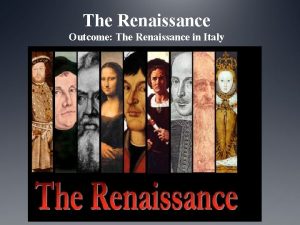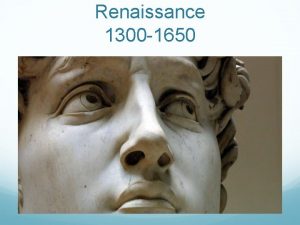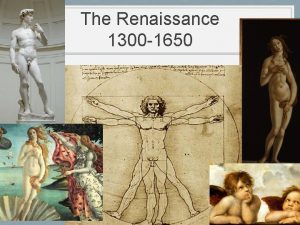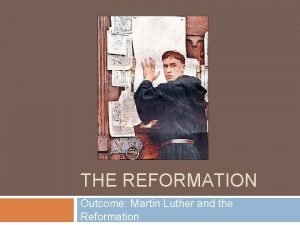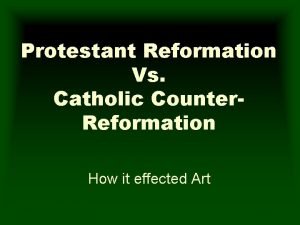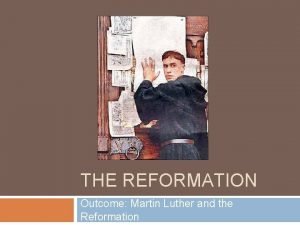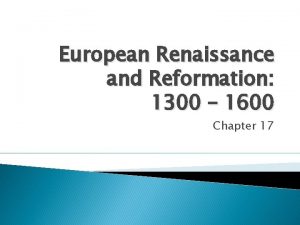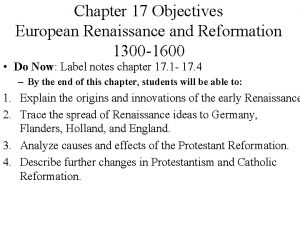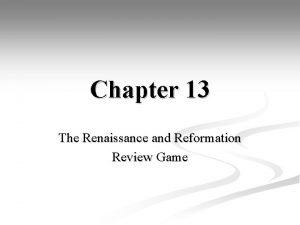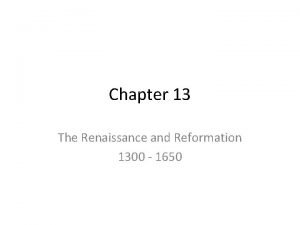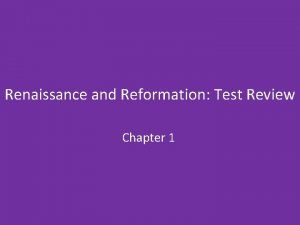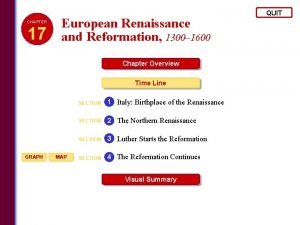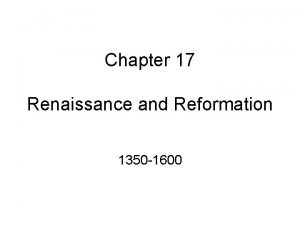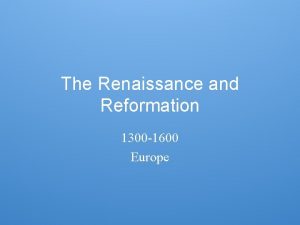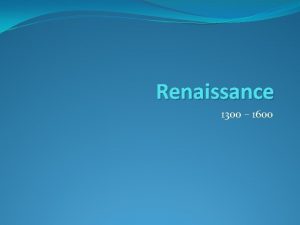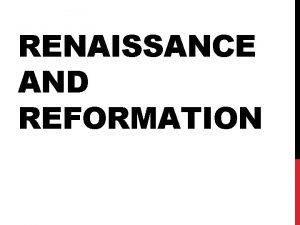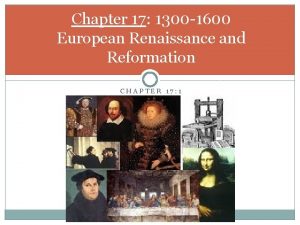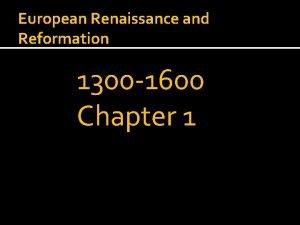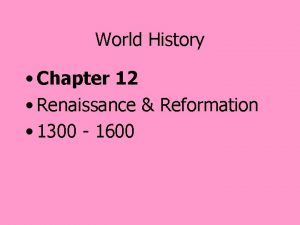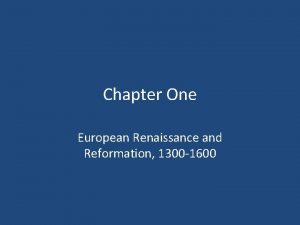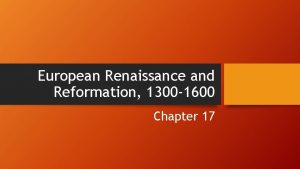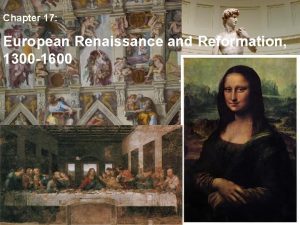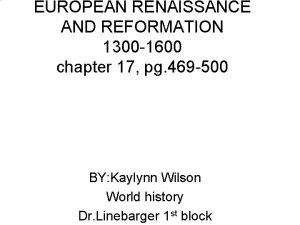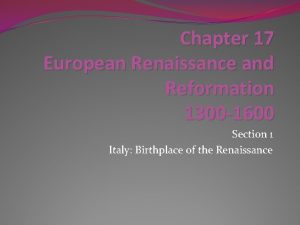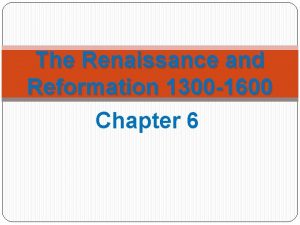Renaissance Reformation 1300 1600 Chapter 1 I Italy















- Slides: 15

Renaissance & Reformation 1300 -1600 Chapter 1

I. Italy: Birthplace of the Renaissance A. Setting the Stage 1. Europe suffered from both war and plague. a) wanted to celebrate life and the human spirit b) began to question institutions of the Middle Ages 2. Church taught to endure suffering while await rewards in heaven

B. Italy’s Advantages 1. thriving cities 2. a wealthy merchant class 3. The classical heritage of Greece and Rome a) Had access to Roman ruins b) Ancient manuscripts from Constantinople

1. The Renaissance a) Term means “rebirth” 1) Refers to a revival of art and learning b) led to innovative styles of art & literature c) led to new values 1) the importance of the individual

2. City- States a) Overseas trade was spurred by the Crusades b) led to the growth of large city-states in northern Italy c) 1300 s, bubonic plague struck these cities, killing up to 60 percent of the population 1) This brought economic changes. 2) fewer laborers could demand higher wages.

3. Merchants & the Medici a) A wealthy merchant class developed in each Italian city-state b) Merchants dominated politics 1) did not inherit social rank 2) believed they deserved power & wealth because of individual merit c) Florence came under the rule of the Medici 1) Lorenzo de Medici, came to power in 1469 2) ruled as a dictator yet kept up the appearance of having an elected government. 3) Famous for being rules & supporters of the arts

4. Looking to Greece & Rome a) artists & scholars drew inspiration from the ruins of Rome b) studied ancient Latin manuscripts that had been preserved in monasteries c) Scholars fled to Rome with Greek manuscripts when the Turks conquered Constantinople in 1453

C. Classical & Worldly Values 1. a) 2. a) 1) 2) Classics Lead to Humanism an intellectual movement that focused on human potential & achievements Worldly Pleasures the basic spirit of Renaissance society was secular worldly rather than spiritual concerned with the here and now

3. Patrons of the Arts a) financially supported artists b) merchants and wealthy families demonstrated their own importance 1) had their portraits painted 2) donating art to the city to place in public 4. Renaissance Man a) Individual who excelled in many fields 1) Baldassare Castiglione wrote The Courtier (1528) a) taught how a young man should behave

5. The Renaissance Woman a) upper-class women also should know the classics and be charming. 1) better educated than medieval women. 2) little influence in politics b) Isabella d’Este 1) Born into the ruling family 2) built a famous art collection 3) skilled in politics

D. 1. a) The Renaissance Revolutionizes Art Perspective technique which shows three dimensions on a flat surface 2. Realistic Painting & Sculpture a) Michelangelo Buonarroti used a realistic style when depicting the human body 1) sculptor 2) poet 3) architect 4) painter

b) Donatello 1) made sculpture more realistic by carving natural postures & expressions that reveal personality 3. Leonardo da Vinci a) A true “Renaissance man, ” b) painter, sculptor, inventor & scientist c) studied how a muscle moves 1) how veins are arranged in a leaf 2) His drawings are an expression of humanistic ideals 3) He portrayed human hands realistically

4. Raphael Advances Realism a) b) c) 1) favorite subject was Madonna & child famous for his use of perspective filled the walls of Pope Julius II’s library with paintings School of Athens, conveys the classical influence on the Renaissance. 5. Anguissola & Gentileschi a) Sofonisba Anguissola was the first woman artist to gain an international reputation. 1) Portrait of King Philip II of Spain. b) Artemisia Gentileschi 1) trained with her painter father & helped with his work. 2) painted pictures of strong, heroic women

E. 1. a) Renaissance writers Change Literature Vernacular – native language Dante wrote in his native language, Italian instead of Latin b) Boccaccio wrote the Decameron 1) a series of realistic, sometimes off-color stories 2) presents both tragic & comic views of life 2. Petrarch & Boccaccio a) Francesco Petrarch 1) wrote Sonnets to Laura (a) 14 -line poems

3. Machiavelli advises Rulers a) 1) 2) Wrote The Prince (1513) the form of a political guidebook not concerned with what was morally right, but with what was politically effective 3) A prince must sometimes mislead the people & lie to his opponents 4) It is best to be both loved & feared but these rarely come together
 Renaissance 1300 to 1600
Renaissance 1300 to 1600 Cosimo de' medici
Cosimo de' medici The renaissance outcome the renaissance in italy
The renaissance outcome the renaissance in italy Renaissance timeline 1300 to 1650
Renaissance timeline 1300 to 1650 Renaissance timeline 1300 to 1650
Renaissance timeline 1300 to 1650 The reformation outcome: martin luther and the reformation
The reformation outcome: martin luther and the reformation Protestants vs catholics
Protestants vs catholics The reformation outcome martin luther and the reformation
The reformation outcome martin luther and the reformation Chapter 17 european renaissance and reformation
Chapter 17 european renaissance and reformation European renaissance and reformation chapter 17
European renaissance and reformation chapter 17 Chapter 13 renaissance and reformation
Chapter 13 renaissance and reformation Chapter 13 renaissance and reformation
Chapter 13 renaissance and reformation The renaissance and reformation test
The renaissance and reformation test European renaissance and reformation answer key
European renaissance and reformation answer key Chapter 12 renaissance and reformation worksheet answer key
Chapter 12 renaissance and reformation worksheet answer key Chapter 17 renaissance and reformation
Chapter 17 renaissance and reformation


